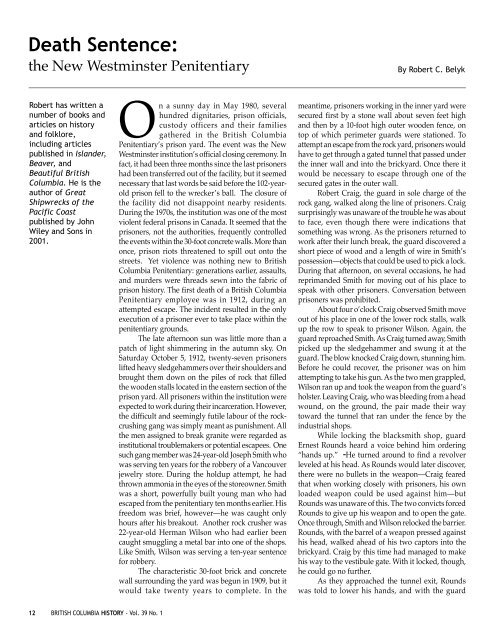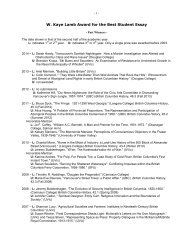bc historic news - BC Historical Federation
bc historic news - BC Historical Federation
bc historic news - BC Historical Federation
Create successful ePaper yourself
Turn your PDF publications into a flip-book with our unique Google optimized e-Paper software.
Death Sentence:the New Westminster PenitentiaryBy Robert C. BelykRobert has written anumber of books andarticles on historyand folklore,including articlespublished in Islander,Beaver, andBeautiful BritishColumbia. He is theauthor of GreatShipwrecks of thePacific Coastpublished by JohnWiley and Sons in2001.On a sunny day in May 1980, severalhundred dignitaries, prison officials,custody officers and their familiesgathered in the British ColumbiaPenitentiary’s prison yard. The event was the NewWestminster institution’s official closing ceremony. Infact, it had been three months since the last prisonershad been transferred out of the facility, but it seemednecessary that last words be said before the 102-yearoldprison fell to the wrecker’s ball. The closure ofthe facility did not disappoint nearby residents.During the 1970s, the institution was one of the mostviolent federal prisons in Canada. It seemed that theprisoners, not the authorities, frequently controlledthe events within the 30-foot concrete walls. More thanonce, prison riots threatened to spill out onto thestreets. Yet violence was nothing new to BritishColumbia Penitentiary: generations earlier, assaults,and murders were threads sewn into the fabric ofprison history. The first death of a British ColumbiaPenitentiary employee was in 1912, during anattempted escape. The incident resulted in the onlyexecution of a prisoner ever to take place within thepenitentiary grounds.The late afternoon sun was little more than apatch of light shimmering in the autumn sky. OnSaturday October 5, 1912, twenty-seven prisonerslifted heavy sledgehammers over their shoulders andbrought them down on the piles of rock that filledthe wooden stalls located in the eastern section of theprison yard. All prisoners within the institution wereexpected to work during their incarceration. However,the difficult and seemingly futile labour of the rockcrushinggang was simply meant as punishment. Allthe men assigned to break granite were regarded asinstitutional troublemakers or potential escapees. Onesuch gang member was 24-year-old Joseph Smith whowas serving ten years for the robbery of a Vancouverjewelry store. During the holdup attempt, he hadthrown ammonia in the eyes of the storeowner. Smithwas a short, powerfully built young man who hadescaped from the penitentiary ten months earlier. Hisfreedom was brief, however—he was caught onlyhours after his breakout. Another rock crusher was22-year-old Herman Wilson who had earlier beencaught smuggling a metal bar into one of the shops.Like Smith, Wilson was serving a ten-year sentencefor robbery.The characteristic 30-foot brick and concretewall surrounding the yard was begun in 1909, but itwould take twenty years to complete. In themeantime, prisoners working in the inner yard weresecured first by a stone wall about seven feet highand then by a 10-foot high outer wooden fence, ontop of which perimeter guards were stationed. Toattempt an escape from the rock yard, prisoners wouldhave to get through a gated tunnel that passed underthe inner wall and into the brickyard. Once there itwould be necessary to escape through one of thesecured gates in the outer wall.Robert Craig, the guard in sole charge of therock gang, walked along the line of prisoners. Craigsurprisingly was unaware of the trouble he was aboutto face, even though there were indications thatsomething was wrong. As the prisoners returned towork after their lunch break, the guard discovered ashort piece of wood and a length of wire in Smith’spossession—objects that could be used to pick a lock.During that afternoon, on several occasions, he hadreprimanded Smith for moving out of his place tospeak with other prisoners. Conversation betweenprisoners was prohibited.About four o’clock Craig observed Smith moveout of his place in one of the lower rock stalls, walkup the row to speak to prisoner Wilson. Again, theguard reproached Smith. As Craig turned away, Smithpicked up the sledgehammer and swung it at theguard. The blow knocked Craig down, stunning him.Before he could recover, the prisoner was on himattempting to take his gun. As the two men grappled,Wilson ran up and took the weapon from the guard’sholster. Leaving Craig, who was bleeding from a headwound, on the ground, the pair made their waytoward the tunnel that ran under the fence by theindustrial shops.While locking the blacksmith shop, guardErnest Rounds heard a voice behind him ordering“hands up.” He turned around to find a revolverleveled at his head. As Rounds would later discover,there were no bullets in the weapon—Craig fearedthat when working closely with prisoners, his ownloaded weapon could be used against him—butRounds was unaware of this. The two convicts forcedRounds to give up his weapon and to open the gate.Once through, Smith and Wilson relocked the barrier.Rounds, with the barrel of a weapon pressed againsthis head, walked ahead of his two captors into thebrickyard. Craig by this time had managed to makehis way to the vestibule gate. With it locked, though,he could go no further.As they approached the tunnel exit, Roundswas told to lower his hands, and with the guard12 BRITISH COLUMBIA HISTORY - Vol. 39 No. 1







